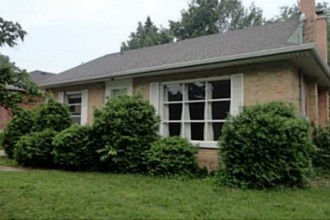Location is the most important factor for good real estate. The overall desirability of the area, the appreciation rate and the eventual resell value are all closely tied to the home you choose.
Locational factors – use your senses
Locational factors fall into two main groups – positive and negative impactors. Your senses: sight, sound, smell, and feel will be needed. One of my 365 Rules about Real Estate is that you cannot buy a home on the internet. Data crunchers who are looking for the Uber of real estate often forget that buying a home is not all about facts and numbers, square footage and assessment values. Homes have a myriad of fuzzy, non-quantifiable influencers.
Sight
People want to live in a attractive place. That may be a leafy neighbourhood with gently rolling hills, like Forest Heights or a smooth hard-scaped urban environment like the condos near Uptown Waterloo.
Also, the way into the neighbourhood should be pleasant. If you have to drive through an industrial park to get there (like driving into Hidden Valley) it takes away from the experience.
In the old days, builders and developers would follow the contours of the land and put houses that made sense in places that suited them (the houses and lots not the developers). Today, the contractors bulldoze the land, remove all the trees and make the surface flat and uniform before they start to build. You notice when you drive around Waterloo Region that the topography of neighbourhoods built until about the late 80s is much more interesting than those built afterwards.
High tension electrical wires, electrical pylons, even electrical transformer boxes in your front yard might want to be avoided. Some of my favourite Kitchener Waterloo neighbourhoods have two really big power lines running through them. They are eyesores and they stigmatize otherwise great real estate.
Sound
At home, people want peace and quiet. I’ve worked with clients who do not want to hear, from their backyard, any road noise. Airplanes taking off or flying overhead is a big turn off for most people and traditionally you don’t want to live too close to a factory or a railway line, though those are harder to find and are a lot less busy than they once were. There is a neighbourhood in Kitchener that complains that they are bothered by the auto garage that moved into the strip plaza mini mall. The air guns are really annoying.
Some people don’t like to live too near to a public school because they find the bells annoying. I think a better reason not to live near a school is the traffic. When I was a kid I never got a ride to school. I used to walk two miles uphill in blizzards and thunder storms to get to school.
And don’t forget about the go karts. They are easily heard from an abutting Waterloo neighbourhood in our city’s north west corner.
Smell
The problem with odours emanating from our local landfill are well known. I’ve worked with people won’t live within six kilometres of the dump, but that cuts out much of Kitchener Waterloo, and is overkill.
Sometimes, no matter where you are in the region you can smell the surrounding farms. ‘Sniff, sniff, ah farm fresh’. That is unavoidable and only happens a couple of times a year. There is a mink farm in the region and you don’t want to live near that. There is also a small oil refinery, so that might be avoided too.
Feel
Some people won’t live near a graveyard, though others appreciate the quiet neighbours. Funeral parlours, massage parlours, tattoo parlours, heck any kind of parlours might want to be avoided.
Across from the back of anything ugly, like a hospital, anything with a loading dock or with bad fengshui (like a water tower) should me stroked off the list, disqualified for looking dangerous, ominous or unlovely.
Lots and Houses
In the olden days, you could get lots of lot and only a little house. I’m currently selling a 900 square foot bungalow that sits on a 50 x 130 foot lot. It’s kind of quaint and rustic, the whole idea, but that was when land was cheap and building was expensive. Now it is the opposite. Gone are the days of a 50, 60 or 70 foot frontage. Now they measure them not in round numbers, but 32, 36 or a 42 foot frontage. So naturally neighbours are closer. Today, we could get three houses on that bungalow’s lot.
With small lots, the yards are smaller. Often the backyard is just big enough for a deck or patio and just a hint of green space. There isn’t as much street parking available either.
Style
Because lots are smaller, the design of houses has changed. Wide bungalows were replaced with back splits and other ‘longer’ types of houses. And, now all we seem to build are two stories.
Exposure
The sun is very important to real estate (and to life on this planet), but this is a preference that changes with people. Personally, I like homes that face east. I like to have the sun streaming in the front windows in the morning and I like having the sunset in my backyard.
Many people want southern exposure. This is the most popular. But when I work with Chinese people, Northern exposure is what they prefer. Zuo Bei Chao Nan.
Because I visit 30, 40 or more than 50 houses a week, in different parts of town, I carry a map around in my head, so I can usually accurately guess which way is east. Of course most of us have phones in our pockets and those have compasses. But if you are like me and you have that map your head or need a handy reference for Kitchener Waterloo, Lancaster Street runs north-south.
Corner lots
Corner lots are not popular with most people. They lack useable yards and can be noisy with traffic going by on two sides. If there is a sidewalk, then there will be twice as much traffic to shovel.
They do however, on a positive note, get more natural light as they don’t have a neighbour on one side.
Other locational factors
School catchment area
Many parents today place a high value on being near a top rated school. This is a chicken and an egg argument, “What came first the good school or the nice neighbourhood?” It doesn’t matter. They tend to go together.
Traffic and transportation
You would like to be on a quiet street, but with fairly easy access to major roads and highways.
In urban environments, you will like to be near mass rapid transportation (LRT) and/or bus routes that run regularly
Neighbours
Bad neighbours leave lots of clues. Do they bring in their recycle bins at the end of garbage day? Do they have more than two cars in the driveway? What kind of cars do they drive and how old are they? What does the landscaping in front of their house look like? Do they have a high fence and security cameras? Is their home in bad repair? Does their house say “welcome” or “stay away”.
You can check on them if you want. You can look them up and find out all sorts of stuff. You can park down the street at different times of the day and night, like a detective on a TV show.
Proximity
You have to find a ‘balance of place’. You want to be close to work, close to shopping, close to your kid’s school.
If you have kids, they have lots of activities that you will want to be close to (like soccer, or gymnastics, cello or hockey, or all of the above). If you don’t have kids, you might want to be close to nightlife. If you have a dog, you might want to be close to a large park or natural area.
Walkability is quickly becoming a factor in choosing good real estate.
Location, location, location
“Everything is 20 minutes away in Waterloo Region”, I’m fond of saying. I really believe you can find the perfect house within 20 minutes of your work or whatever the most important other place in your life is.
I think location is more important than house. Choose a great location and then find a suitable home within it.





